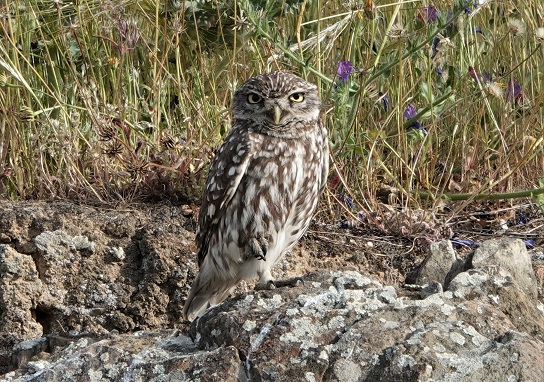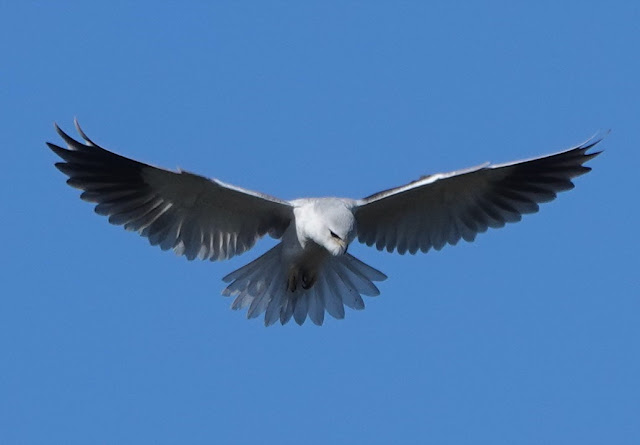The Global Birding Weekend in Extremadura
 |
| The Global Bird Watch weekend saw many arriving Common Cranes (Martin Kelsey) |
October is often considered a bit of an in-between month in Extremadura. The great wave of trans-Saharan migrants such as flycatchers, Common Redstarts, Whinchats and Ortolan Buntings has peaked in September as they paused to refuel. The often exciting variety of waders on overland migration has mainly passed through. Winter visitors are starting to appear, but it will not be later in the month that their numbers build up to reach the amazing spectacle which is winter birding here. And whilst we sometimes find unexpected rarities, as elsewhere, in October, we can never compete with the coastal sites.
So it was with great curiosity that five members of GUIDEX, the association of nature guides in Extremadura, formed a team called "Extremadura Birding Guides" to register as part of the Global Birding Weekend. Together with about a hundred teams and thousands of individuals across over 120 countries, we spent the weekend of 17th and 18th October out in the field, as a worldwide celebration of birds. Saturday 17th was also the long-running Global Big Day, organised by eBird, a huge network of birders around the world. All of our sightings could be tallied up as part of the Global Big Day, and we could continue through Sunday 18th October as well to submit what we had seen.
But how many species could we reasonably expect to see? In a full week of birding in the peak of spring one can expect to see over 150 species of birds in Extremadura, and if there happens to be a very good wader passage or there are still some wintering duck hanging around, then the figure can approach 180 species. On the other hand, if sheer listing is not the priority and one wants to spend as much time looking at plants or insects as one does at birds, or savouring the historic heritage of the region, then a relaxed 110 or 120 species is still a happily satisfying total. It all depends on your pace and priorities. But what about in just two days? And in mid-October?
The first thing that was clear was that we were not aiming to win any competition...the event was global and included people birding in places like Colombia, the country with more species of birds than anywhere else. We would also, as has been the theme for activities ever since the COVID pandemic struck, operate as a virtual team. We would individually do our own thing, in our own way and combine our totals. We also agreed that the focus should also be relaxed and enjoyable.
 |
| Alcollarín Reservoir, one of the sites visited on Day 1 (Martin Kelsey) |
So the team members set their own itineraries. On the Saturday, I would start with a local walk from home and then with Claudia drive to nearby favourite birding sites: the rice fields and Alcollarín Reservoir. In Sunday I had to take part in a national radio interview, to be recorded in the north of Extremadura, and on our return home we would visit the Monfragüe National Park and then the plains north of Trujillo. Jesús Porras, based in Trujillo would focus on the plains close to the town on the first day, and then make a visit to a small reservoir nearby and go to Arrocampo reservoir on the Sunday. Hugo Sánchez, Raquel and Fran Espinosa would bird together on the Saturday, going to the plains and some wetlands near Cáceres and Plasencia. On Sunday, they would bird independently close to their homes in the north of the region. José Luis Bautista already had planned to be away in Portugal that weekend, but would manage some birding en route. Finally Godfried Schreur would focus entirely on the variety of habitats within walking distance from his home in La Codosera in the west of the region, indeed he only drove a total of 15 kilometres the whole weekend. So we concentrated on places we knew well, leaving vast swathes of Extremadura untouched.
 |
| Monfragüe National Park Day 2 (Martin Kelsey) |
The first bird listed on the Saturday was a Red-necked Nightjar by Hugo, Raquel and Fran as they headed south towards Cáceres. At first light on the plains, they had picked up Great Bustards and Black-bellied Sandgrouse, and a rather late Montagu's Harrier. Godfried on his walk in the first half of the morning was also finding late migrants in the form of Subalpine and Garden Warblers. On my wander along the lanes near home, what was particularly striking has the large passage of arriving Song Thrushes and Skylarks, as well as a small group of Common Cranes. The fine, settled weather was ideal for migration. Meanwhile Jesús, just outside Trujillo, was also on plains, adding emblematic species like Little Bustard, Pin-tailed Sandgrouse and Spanish Eagle to our list, as well as wintering Merlin and Hen Harrier.
By late morning, Claudia and I paused by a small pond, at the edge of a neighbouring town, where the highlights were a Black Stork and a female Red-crested Pochard. Not far from there, we watched an Eagle Owl enjoying the autumn sunshine. Meanwhile Hugo, Raquel and Fran had stopped at a reservoir close to Cacéres and found four more Red-crested Pochard as well as a small group of migrating Pintail. Jesús had pulled a late Lesser Kestrel out of the bag, as well as a large flock of over 500 Spanish Sparrows. Just outside the territory, José Luis added a Black-winged Kite. It turned out to be the only one seen over the weekend by the team, although had he been visiting one of his local patches near Mérida, he would almost certainly have found a pukka Extremaduran one.
 |
| Newly arrived Water Pipit (Martin Kelsey) |
Claudia and I spent the middle part of the day on the rice fields, seeing well over a hundred newly arrived Common Cranes, some obliging Water Pipits and the only Bluethroat of the weekend. Rice harvesting was well underway and on some ploughed-over wet fields a range of wader species were present. At one moment they all took off, as a Peregrine made a couple of dramatic sweeps across the fields. However because of illegal stubble-burning, the pall of smoke was decidedly unpleasant, so regrettably we retreated, but not before stopping to admire a stunning clump of Serotine Narcissus in flower. At this time, Hugo, Raquel and Fran had moved to a deep river valley, finding hoped-for Black Wheatear, as well as Blue Rock Thrush. Jesús at a river valley to the east picked up Bonelli's Eagle.
We concluded the day at Alcollarín Reservoir, seeing more migrant Pintail, Kentish Plovers (which we had missed on the rice fields) and a magnificent pair of Golden Eagles soaring overhead. There was no sign of the long-staying Greater Flamingo, but no worries, Hugo, Raquel and Fran found three at another site to the north. After that they stopped at a pool near Galisteo. Now this is one of those places that seems to draw rarities in like a magnet. Nothing mega was present this time, but a Ferruginous Duck was a nice find, and the only one for the weekend.
Some team members continued after sunset, Jesús finding both species of nightjar close to Trujillo, as well as another Eagle Owl for the list, whilst Fran added Tawny Owl. That brought our total for the day to 146!
 |
| Serotine Narcissus (Martin Kelsey) |
Godfried's strategy of staying close to home in the wonderful surroundings of La Codosera certainly paid off on Sunday with Goshawk and Bullfinch. The latter is a very localised and scarce winter visitor to Extremadura. Fran found a Redwing and, to his great relief, Lesser Spotted Woodpecker. It turned out to be the only one for the team. It is normally a dead cert for him close to home, but had been elusive. Hugo also added what, surprisingly, was our only Firecrest. I had spent most of the morning at the radio interview, so only started birding midday. We headed to the Monfragüe National Park to be treated with displaying Spanish Eagles and a single Bonelli's Eagle.
 |
| Displaying Spanish Eagle (Martin Kelsey) |
Godfried added Grasshopper Warbler, a great find. Jesús in the meantime had spent the afternoon with his partner Sandra at Arrocampo reservoir for Purple Swamphen and Little Bittern, and an Osprey was a useful bonus. Not wanting to rest on his laurels, they then found a group of seven Dotterel on their return home, just outside Trujillo. The final bird for the team was a Barn Owl, which Jesús saw close to home as he was taking his dog for a walk.
The Barn Owl brought our list to an amazing 161 species (or 160 if the cross-border Black-winged Kite is excluded), including 18 species of diurnal birds of prey. So much for October being a quiet month! It is a total which we would have been happy with at any time of the year and well beyond our expectations. And apart from Godfried's highly productive walks, we had barely touched the southern province of Badajoz and missed species like Penduline Tit and Red-billed Chough. But it is in the nature of this type of exercise that a few regular species get missed, but usually they are compensated for by surprises. That was certainly the case this time.
It was great to feel part of an activity which across the world on the Saturday recorded over 7000 species of birds with over 30,000 participants. But most of all it was a hugely enjoyable and relaxing experience, there was no pressure. It was curiosity which drove us. And curiosity is the best driver of all.
 |
| Great Bustards at the end of the day (Martin Kelsey) |



Comments
I was struck by your use of the name "Spanish Eagle" - is that the accepted name these days, with "Imperial" dropped? I think you used to use Imperial in your descriptions on this blog.
Best wishes
Matt Evans